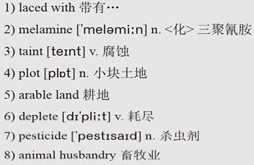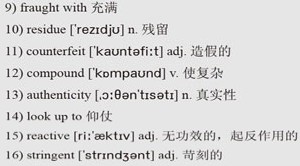文字难度:★★★☆
Three years ago, China was rocked by food safety concerns when the powdered milk that parents were feeding their infants was found to be 1)laced with 2)melamine, an industrial chemical. Scores of babies were sickened, with some even dying. And from that 3)tainted milk to the latest tainted pork—also known as “lean meat powder”—food safety issues never fail to stir fear and anger. Domestic worries have attracted global attention and questions—especially since China is the largest exporter of food products in the world. The public can't help but wonder: what's wrong with the food? And most importantly, what's wrong with the food safety system regulating the whole industry?
三年前,当家长发现他们喂宝宝的奶粉里含有三聚氰胺这种化学物质时,对食品安全的担忧震动了全中国。不少婴儿患病,有些甚至因此死亡。从当时的毒奶粉到最近的毒猪肉——也称为“瘦肉精”——食品安全的话题不断引起恐惧与愤怒。中国国内的忧虑不安引发了国际社会的关注与质疑——特别因为中国是全球最大的食品出口国。公众不禁怀疑:食品到底怎么了?最重要的是,规范整个行业的食品安全机制到底是怎么了?
 For centuries Chinese farmers have been intensely cultivating their small 4)plots, leaving much of China's scarce 5)arable land 6)depleted. Nevertheless, for the past twenty years agricultural production has grown in China due to an extremely high use of fertilizers and 7)pesticides on crops and drugs in 8)animal husbandry. Thus, it is not surprising that Chinese agricultural products are 9)fraught with many drug and fertilizer 10)residue problems. What's more, it has been estimated that 40 percent of all pesticides in China are 11)counterfeit, further 12)compounding the problem of over-application with doubts surrounding 13)authenticity and actual content. What's to be done?
For centuries Chinese farmers have been intensely cultivating their small 4)plots, leaving much of China's scarce 5)arable land 6)depleted. Nevertheless, for the past twenty years agricultural production has grown in China due to an extremely high use of fertilizers and 7)pesticides on crops and drugs in 8)animal husbandry. Thus, it is not surprising that Chinese agricultural products are 9)fraught with many drug and fertilizer 10)residue problems. What's more, it has been estimated that 40 percent of all pesticides in China are 11)counterfeit, further 12)compounding the problem of over-application with doubts surrounding 13)authenticity and actual content. What's to be done?
千百年来,中国的农民在自己那一方小地上深耕密种,大部分珍贵耕地已“油尽灯枯”。然而,在过去的二十年间,由于高强度地使用化肥、杀虫剂以及对禽畜使用药物,中国农产量增加。因此中国农产品总是发现有农药、杀虫剂残留。更麻烦的是,有统计显示,中国40%的杀虫剂是假冒伪劣品,里面其实是些什么成分呢,这其中真真假假的疑团进一步让“农药用量过度”的问题复杂化。我们能做些什么?
First, let's take a look at how a successful food safety regulation structure works. The European Union and Japan are who other countries should 14)look up to. A successful food safety regulation structure must include the active collaboration of the government, food safety technology leaders, and the food industry. An effective food safety system must be comprehensive, for relying solely on testing imports is 15)reactive and potentially expensive if done in isolation. Conversely, simply depending on a third party or exporting country to test is risky and requires monitoring to ensure tests are done well. Ideally, food safety regulations would be internationally harmonized; however, that has not yet happened. Among exporting countries it has long been considered that the EU has the most 16)stringent legislation.
首先,让我们看看成功的食品安全监督机制是如何运作的。欧盟与日本是其他国家仰仗的例子。一个成功的食品安全监督机制需要政府与食品安全技术的领头羊们以及整个食品行业之间的协作配合。一个有效的食品安全机制必须涉及广泛,因为如果单一蛮干的话,完全依靠测试进口食品就是做无用功并且潜在的花费很昂贵。相反,如果仅靠第三方或出口国来测试,危险系数很高,并且需要监控测试的准确性。最为理想的是,食品安全机制由全球通力合作,但这还尚未得以实现。在所有食品出口国中,欧盟被视为立法最为严厉的。
The European Union. The strengths that distinguish the EU's food regulatory system are: (1) the regulating body—the European Food Safety Authority—an independent, scientific point of reference for risk analysis, ensuring that food safety regulations are based on science; (2) a comprehensive system for 17)traceability of foods; (3) a rapid alert system for food and 18)feed to 19)disseminate information on risks within the European Community; and (4) a requirement that food imported from third countries are produced and tested with the same 20)diligence as domestic produce.
欧盟食品监督机制区别于其他地区的是:1)监管主体——欧洲食品安全局——是一个从科学角度分析食品安全性并科学地制定食品安全准则的独立机构;2)一个全面的食品来源追踪机制;3)一个快速的食品及饲料安全报警机制,能把有害食品的信息在欧盟范围内传播;4)要求从第三国进口到欧盟内的食品要符合区内的生产与检测标准。
The Japanese System. The strengths of the Japanese system are: (1) compliance to Japan's food safety standards is ensured through a very high level (>10 percent) of laboratory testing for imports; (2) the 21)onus is placed on importers to prove the safety of their products by having them tested before import is allowed into Japan. One of the more demanding aspects of the Japanese food inspection regulations is the large list of 22)substances that importers must test.
日本监管机制的“闪光点”在于:1)日本进口食品的标准定得非常高(比实验室测试水平还要高10%);2)出口国需负责确保食品出口到日本前经过检测并证实安全,食品才获准进入日本;日本食品安全准则里其中较为严苛的是给出口国列出了长长的清单,要求他们必须检验食品是否含有那一系列物质。
Both of these systems are successful, for a number of reasons. The Food and 23)Veterinary Office of the EU Commission has the authority to inspect the facilities of importers and ensure traceability so that individual facilities can be checked for compliance. Besides certifying third country establishments to export certain foodstuffs, the inspections by the EU's Food and Veterinary Office also provide countries with recommendations to improve their testing of food exports. Whilst Japan does not maintain approved lists, Japan will dispatch government experts to exporting countries when problems are identified. Both Japan and the EU provide a public list of food safety violations; however, the Japanese list is only posted quarterly, rather than on a 24)rolling basis like the EU. Both the EU and Japan are quick to require considerably more testing or completely ban products after multiple violations. Unlike Japan, the EU food regulatory system does not prescribe analytical techniques for testing. This is seen as a significant strength, which allows European laboratories to improve efficiency through the adoption of new technologies as they are introduced by the technology suppliers.
这两个地区的食品监督机制那么成功是有原因的。欧盟委员会食品与兽医办公室有权检查进口商的设施并且确保可以对其进行追踪,这样就可以检查个别设施是否合格。除了派人对欧盟外第三国的出口商设施作检查认证外,食品与兽医办公室还向出口国提供出口测试机制的改善建议。虽然日本没有详细的认可出口商清单,但一旦进口食品有问题,日本会派遣专家到该出口国调查。日本和欧盟都会向大众公布违规的危险食品清单;但日本方面是每个季度才公布一次,不像欧盟那样随时更新发布。发现有多次违规行为后,日本和欧盟都会迅速要求对该种食品进行进一步检测或是禁止进口。和日本不同的是,欧盟没有对食品安全检测的分析检测技术进行规定。这点被视为有力的手段,让欧洲的实验室可以运用技术供应商提供的新技术来提高测试效率。
Another model to look at is the American system. The US food safety system is highly dependent on voluntary industry participation, which is motivated by the need to ensure consumer confidence. Food is also kept safe by strong consumer safety laws, and independent legal system, free media, and civil society organizations. But China lacks many of these institutions, most notably a strong self-regulating 25)private sector, due in great part to such industries being protected by local governments that own them. For China's food market to move forward on both an international and domestic scale, a successful food safety regulation structure will need to be developed and standardized. Thus, Chinese regulators must design a food safety system of their own. Not just for export, but for themselves.
另一个例子是美国的机制。美国食品安全机制非常倚重行业的自主性,而这是为了保证消费者的信心而确立的。保障食品安全还包括强有力的消费者安全法,独立司法体系,媒体自由报道以及民权组织。但中国没有这些机制,尤其缺乏具有高度自律性的私营业界,原因主要在于食品行业往往为地方政府所有,问题往往被包庇纵容。中国的食品市场想要在国内或是国外想要取得发展的话,就要建立一个行之有效的食品安全机制,并对其规范化。因此中国的监管部门有必要建立属于自己的食品安全机制。不仅仅为了出口,更是为了自己。




